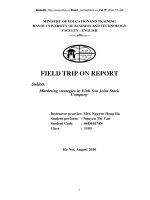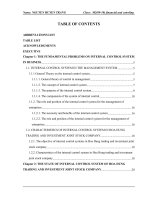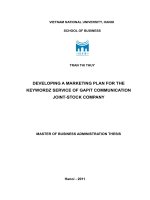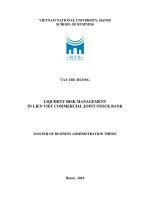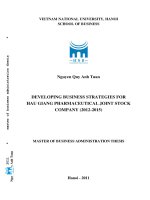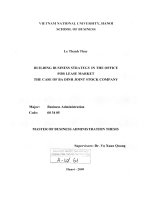MARKETING ACTIVITIES IN AN CHAU PHARMACEUTICAL JOINT STOCK COMPANY
Bạn đang xem bản rút gọn của tài liệu. Xem và tải ngay bản đầy đủ của tài liệu tại đây (798.58 KB, 97 trang )
FOREIGN TRADE UNIVERSITY
FACULTY OF BUSINESS ADMINISTRATION
---------***---------
GRADUATION THESIS
Major: International Business Administration
MARKETING ACTIVITIES IN AN CHAU
PHARMACEUTICAL JOINT STOCK COMPANY
Student full name
Student ID
Class
Intake
Supervisor
Hanoi, May 2015
: Tran Thi Thanh Tam
: 1113250035
: English 14
: 50
: MBA. Nguyen Duc Nhan
ACKNOWLEDGEMENT
This graduation thesis is the result of thirteen weeks of research and writing
during the last semester of my final academic year at Hanoi Foreign Trade University.
It has been an interesting and learning experience. In fulfilling this thesis, I would like
to give my special thanks to many people for their significant help, contribution and
recommendation during my writing process.
First and foremost, I am heartily thankful to my supervisor, MBA. Nguyen Duc
Nhan, whose encouragement, guidance and support from the initial to the final level
enabled me to develop an understanding of the subject.
Secondly, special and grate thanks must go to all the managers, staffs and
customers of An Chau Pharmaceutical Joint Stock Company, Ha Noi Capital for their
cooperation that helped me in this study.
Futhermore, I offer my regards and blessing to my family and friends who
support respect during the completion of the thesis.
Lastly, gratefulness is to the readers whose feedback will help much in improving
the thesis.
Hanoi, April 2015
Tran Thi Thanh Tam
i
ABSTRACT
The graduation thesis represents the results of research on marketing activities
of An Chau Pharmaceutical Joint Stock Company. The purposes of this study are to
identify the marketing activities of An Chau Pharmaceutical Joint Stock Company and
measure factors affecting to the marketing activities. Then, base on that, some
recommendations are put forward to help An Chau PJSC improve the quality of
medicines and enhance the effective of marketing activities.
Currently, An Chau PJSC has launched drugs in all 63 provinces and cities in
Vietnam. However, due to some reasons both objectively and subjectively, it is
impossible to conduct the research on marketing activities in all provinces and cities in
Vietnam. Therefore, an area should be selected to be the representative for the whole
country. In this thesis, Some province like Ha Noi, Nghe An, Ha Tinh, Da Nang, Hai
Phong is chosen to study because it is the most convenient area for the researcher. In
addition, this branchs has a huge number of customers of An Chau PJSC. Therefore, it
may be given more accurate information and able to take the right actions.
Questionnaires were sent out to 210 customers of An Chau PJSC in some province
above but only 150 collected responses were usable.
ii
TABLE OF CONTENTS
TABLE OF CONTENTS..............................................................................................i
LIST OF ACRONYMS...............................................................................................iv
LIST OF TABLES AND FIGURES............................................................................v
1. INTRODUCTION....................................................................................................1
1.1. Background and cause of this paper:...................................................................1
1.2. Objective.............................................................................................................2
1.3. Research questions..............................................................................................3
1.4. Research scope....................................................................................................4
1.5. Structure of the thesis..........................................................................................4
2. LITERATURE REVIEW........................................................................................5
2.1. Overview about Marketing..................................................................................5
2.1.1. History of Marketing....................................................................................5
2.1.2. Definition of Marketing................................................................................7
2.1.3. The Role of Marketing..................................................................................8
2.1.4. Marketing in pharmaceutical.....................................................................10
2.2. Basic content of Marketing Mix........................................................................10
2.2.1. Product.......................................................................................................11
2.2.2. Price...........................................................................................................18
2.2.3. Place...........................................................................................................22
2.2.4 Promotion..................................................................................................24
3. RESEARCH METHOD.........................................................................................29
3.1. Pharmacy marketing research............................................................................29
3.2. Research process for thesis................................................................................29
3.2.1. Recogniance survey....................................................................................29
3.2.2. Questionnaire design..................................................................................29
iii
3.2.3. Data collection...........................................................................................31
3.2.4. Conducting the results................................................................................31
4. DISCUSSION AND FINDING..............................................................................32
4.1. Company background........................................................................................32
4.1.1. General information...................................................................................32
4.1.2. Establishment and development process.....................................................32
4.1.3. Vision, mission, values................................................................................33
4.1.4. Organization chart.....................................................................................35
4.1.5. Human resources........................................................................................36
4.1.6. Production..................................................................................................37
4.1.7. Monthly financial result..............................................................................38
4.2. Analyzing marketing activities of An Chau PJSC..............................................39
4.2.1. Factors affecting the marketing activities in An Chau PJSC.....................39
4.2.2. An Chau PJSC market................................................................................47
4.2.3. Distribution strategy...................................................................................47
4.2.4. Price...........................................................................................................50
4.2.5. Product.......................................................................................................53
4.2.6. Promotion and business assistance policy..................................................59
4.3. Pros and cons of An Chau Pharmaceutical Joint Stock Company’ marketing
environment.............................................................................................................. 63
4.3.1. Strengths.....................................................................................................63
4.3.2. Weaknesses.................................................................................................63
5. SOME SUGGESTIONS FOR THE MARKETING ACTIVITIES OF AN
CHAU PJSC................................................................................................................66
5.1 Objectives and development orientations of the company..................................66
5.2. Oriented strategies from the SWOT matrix Marketing......................................67
5.3. Customer feedback about the marketing activities at An Chau PJSC...............69
iv
5.4. Some supporting solutions for Marketing activities...........................................69
5.4.1. Improving and developing the market research activities...........................70
5.4.2. Improving product activities.......................................................................70
5.4.2. Improving pricing activities........................................................................72
5.4.3 Improving distribution activities..................................................................74
5.4.4 Improving promotion activities....................................................................75
5.5. Limitations of the study and suggestions for future work..................................77
5.6. Contributions of the study..................................................................................78
REFERENCE...............................................................................................................a
v
LIST OF ACRONYMS
R&D
PJSC
SMBs
ETC
OTC
BOD
ROE
Research and Development
Pharmaceutical Joint Stock Company
Small and medium enterprises
Ethical Drugs
Over the counter
Board of Directors
Return On Equity
vi
LIST OF TABLES AND FIGURES
Figure 2.1. The Marketing Mix Model
16
Figure 2.2. Product levels
18
Figure 2.3. Stages on the Product Life Cycle Marketing
19
Figure 2.4. Channels of distribution
28
Figure 4.1. Logo of An Chau Pharmaceutical JSC
37
Figure 4.2. Organizational structure of the company
40
Figure 4.3. Growth of the total amount used drugs Vietnam
46
FIGURE Figure 4.4. Distribution channel of An Chau PJSC
TABLE
53
Figure 4.5. Product Structure of An Chau 2014
60
Figure 4.6. The dosage form, levels, packing of paracetamol
62
Figure 4.7. Form of advertising signboards drugstores
65
Table 4.1: Revenue, profit and retained earnings from 2012 – 2014
44
Table 4.2. Revenue on customer group
53
Table 4.3. The Sale Promotion Program of An Chau PJSC in 2015
57
Table 4.4. The discount policy for clinics and hospitals
58
Table 4.5. The product development portfolio in width in 2014
59
Table 4.6. The revenue of Children product group
61
Table 4.7. Portfolio of ingredient liver medicine in 2014
61
Table 4.8. The development of products which have Ginkgo Biloba
64
vii
1. INTRODUCTION
1.1. Background and cause of this paper:
Economic crisis has led to the decline of areas of the economy while Medicine
Industry is still considered to grow with the average speed growth of 18.8 % per year in
a 5-year period from 2009 to 2013 (ViettinbankSc Report, 2014). The primary factor
that impacts on this trend is that medicine can not be replaced by any other products
and the awareness of Vietnamese about medical and health care has also improved.
Vietnamese pharmaceutical market has the highest growth level in South-east Asia,
about 16% every year (ViettinbankSc Report, 2014). The total consumption value of
tobacco was $3.3 billions in 2013 and it is predicted to increase by $10 billions in 2020
(FPTS Report,2014).
All the sectors of the economy are accepted and can participate in Vietnamese
medicine market for advancing medicine supply. By the end of 2013, there has been
4560 enterprises participating in supplying and contributing medicine, there are 1336
domestic medicine enterprises among them and 425 foreign ones that are licensed for
business activities in Vietnam (FPTS Report,2014). The participation of private
companies with their simple organizational structures,flexible business strategies and
high adaptation to market fluctuation has contributed to change Vietnamese medicine
market. Medicine market is getting overheating with average speed of growth 17%
(FPTS Report,2014). However, most of medicine private businesses have small scales,
limited economic potential, small nomenclature and severe competition between
companies as well. When it comes to this situation, if the medicine enterprises want to
develop stably, they have to not only attach special importance to both technology and
human resources’ investment but also specially attend to handle marketing strategies
creatively in order that they can get market opportunities and their own competitive
advantages. Marketing strategy do not always decide an enterprise’s success or failure;
nevertheless, it is indispensable.
1
An Chau Pharmaceutical joint-stock company, a private company which majors at
producing and dealing in domestic medicine. It is trading in an overheating market
filled with opportunities but threats as well. If it want to exist and develop, it is
essential that this company should have a certain marketing strategy and proper
solutions to compete with its rivals. (currently, the company just provides general
solution and has not had an official marketing department). Therefore, I suggest that
implementing a project to analyze the marketing activities at An Chau Pharmaceutical
Joint Stock company is a necessary step to meet the customers’ demand and evaluate
the effective of marketing activities.
With this actual condition and my internship period at An Chau PJSC, I hope that
my topic which is about “ Marketing activities of An Chau Pharmaceutical joint – stock
company ” will assist the company in having a general look at its current Marketing
activities and solutions given will support the company to improve their medicine
business operation, which is expected to contribute to advance their revenue and profits
as well.
1.2. Objective
An Chau PJSC is a local company, with 5 years of construction and development
medicines. The company has been strides and achieved relatively good results. But the
economic situation of open competitive today, the company faced many difficulties.
The current marketing strategy of the company purely generic, while Marketing has a
very important role.
The research topics of significance in terms of practicality. Topical help
companies with the overall look of marketing activities in recent years and propose
some solutions to improve business performance of the company Pharmaceuticals.
Besides, the subject can be used as materials for the project, other research on the role
and performance of Marketing, the performance of pharmaceutical companies in the
next phase. Besides, the application of knowledge Marketing_Mix, through analysis of
the actual economy, from customers as well as the current situation of the company to
2
find out the causes of the present marketing activities of companies are not really
effective, which proposed a number of measures the company may consider applying
to improve business performance in the future.
The purpose of this thesis is to investigate the current marketing practices of
pharmaceutical companies through a literature search, case studies and interviews. The
literature search focussed on the regulations and guidelines that control the promotion
of pharmaceutical products in Vietnam markets.
The case studies focussed on how the companies promoted and influenced
patients to buy their products through television commercials and websites in order to
keep their market share and maybe entice new customers to buy it.
1.3. Research questions
The key question of this study is: “How do marketing activities of An Chau
Pharmaceutical Joint Stock Company influencing the customer satisfaction throught
4P, especially product, price and promotion?” To answer this question, it is necessary to
answer the following these sub-questions:
How did An Chau pharmaceutical PRODUCTS perform? (Overall quality,
First use experience, Usage experience,...)
How is the An Chau’s promotion program? (discounts, PR....)
Overall, how satisfied were you with price of medicines of An Chau
Pharmaceutical JSC?
Interviews were done with a series of 10 questions with An Chau 's customer to
find out their opinions on current marketing practices of the companies, the influence
of gifts from pharmaceutical representatives on prescribing or selling particular drugs
and opinions on Direct-to-Consumer (DTC), internet advertising, and how this effects
and controls their decisions on prescribing or selling particular brands of drugs.
Interviews were also preformed with some pharmaceutical representatives (doctor) to
find out their opinions on their own positions within the pharmaceutical industry, their
backgrounds, and their individual approaches in selling their particular products.
3
1.4. Research scope
This study focuses on measuring the level of satisfaction about marketing
activities of An Chau PJSC of customers in Nghe An Province (50 clients), Ha Noi
Capital (50 clients), Ha Tinh province (20 clients),Hai Phong (10 clients), Hai Duong
(10 clients), Da Nang (10 clients) where there have major big customer of An Chau
PJSC since the beginning of March 2015.
210 customers of An Chau PJSC who is owner of drugstore, pharmacy, clinic in
these place that is mentioned above have been invited to do survey with the hypothesis
that they will fit with the whole population of An Chau PJSC customers in Vietnam.
1.5. Structure of the thesis
At the beginning of the thesis there is a short description and defination of
Marketing, Marketing activities in Pharmacy company. The author carries on to
theories that are implicated in the different parts of the actual marketing plan. The
results of the research will be applied in the marketing plan that will be the next and
central part of the thesis. The marketing plan will consist of five parts:
An introduction about background, purpose and research method
Literature review about Marketing, Marketing activites and factors in the
Pharmacy company
Research method
Dicussion and Finding
Orientation toward marketing activities and suggestions for An Chau
Pharmaceutical Joint Stock Company.
4
2. LITERATURE REVIEW
2.1. Overview about Marketing
2.1.1. History of Marketing
Marketing terminology used for the first time in 1902 in the lecture hall at the
University of Michigan, US, until 1910, all the general university in the US began
teaching this course. During almost half a century, marketing was taught only within
the English-speaking countries. Until after World War II, in the 50s and 60s of the
twentieth century, it spread to new Western Europe and Japan. Internationalization
process of marketing has grown very fast.
Led by marketing scholars from several major universities in the world, the
development of marketing was motivated by the need to analyze relationships and
behaviors that existed between sellers and buyers. In particular, the research of
marketing led sellers to recognize that adopting certain strategies and tactics could
notably benefit the seller/buyer relationship. Before the 1950s, Marketing often meant
identifying strategies and tactics for simply selling more products and services with
little link for what customers really wanted. Often this meant companies embraced a
“sell-as-much-as-we-can” philosophy with little interest in building relationships for
the long term.
But starting in the 1950s, companies began to recognize that old ways of selling
were not really effective. As competition grew stiffer across most industries,
organizations looked to the buyer side of the transaction for ways to improve. What
they found was an emerging philosophy suggesting that the key factor in successful
marketing is understanding the needs of customers. Today enterprises want business
achieve higher economic efficiency needs to have an understanding and application of
modern marketing.
Besides that, the concept of marketing that we now see has more to do with
developments during the industrial revolution of the 18th and 19th centuries. This was
a period of rapid social change driven by technological and scientific innovation. One
5
result was that for the first time the production of goods was separated from their
consumption. Mass production, developing transport infrastructure and growing mass
media meant that producers needed to, and could develop more sophisticated ways of
managing the distribution of goods.
For much of the industrial revolution goods were generally scarce and producers
could sell pretty much all that they could produce, as long as people could afford to
buy them. For much of the industrial revolution goods were generally scarce and
producers could sell pretty much all that they could produce, as long as people could
afford to buy them. Their focus was on production and distribution at the lowest
possible cost and what marketing management (for example, reducing distribution
costs, opening new markets).
From the start of the twentieth century to the period following the Second World
War (although the development was interrupted by the wars) competition grew and the
focus of marketing turned to selling. Communications, advertising and branding started
to become more important as companies needed to sell the increasing outputs of
production in an increasingly crowded market. Marketing was therefore still a 'slave' to
production, but focussed on distribution, communication and persuading customers that
one manufacturers goods were better than another.
Marketing terms appear in the early years of the twentieth century, the first time
ever in the US. But after the world economic crisis (1929 - 1932) and especially after
World War II (1941 - 1945), Marketing reached the leap, strong growth in both
quantity and quality to really become a popular field of science today.
From the 1960s onwards most markets have become saturated (the size of the
market remains the same). This means that there is now intense competition for
customers. The sophistication of marketing management has therefore developed into
what we now see in a modern marketing department. Marketers are involved at a
strategic level within the organisation and therefore inform an organisation about what
should be produced, where it should be sold, how much should be charged for it and
how it should be communicated to consumers. Modern marketers research markets and
6
consumers. They attempt to understand consumer needs (and potential needs) and
allocate organisational resources appropriately to meet these needs. Modern marketers
are particularly interested in brands. They are also increasingly interested in ensuring
that employees understand marketing, i.e. that everyone within the organisation
involves themselves with marketing activities.
First department of European Marketing was established in 1968 in the city Grai
of Austria. The process of internationalization of Marketing rapid development, today
almost all universities in the world are teaching of Marketing and Marketing
applications are also a very effective way in the field of business everywhere.
2.1.2. Definition of Marketing
Along with the development over time, the Marketing has many different
concepts. The concepts depends on the actual circumstances and different perceptions
that people have different ways of defining Marketing. The difference is not only in the
level of detail, but also reflected in the content its contains. But in short, the advent of
Marketing effectively to support business operations, sales and marketing of products.
According to the American Marketing Association (AMA) Board of Directors,
Marketing is the activity, set of institutions, and processes for creating, communicating,
delivering, and exchanging offerings that have value for customers, clients, partners,
and society at large. Overall this is a quite perfect concept with many advantages.
Firstly, this concept indicate that the product being exchanged is not limited to tangible
goods but also ideas and services and Marketing is not only apply to the business
activities aimed at profit. Secondly, it define clearly the functions of marketing not only
the sale or distribution. This concept access Marketing functional perspective, when it
talk about 4P in Marketing, this is also the approach of some curricula in Marketing in
Vietnam because this concept carries the advantage of being simple and high
applicability. The approach is matching the marketing management process that Philip
Korler offering.
In other hand, Julie Barile – Vice President of ecommerce, Fairway Market said
that marketing was traditionally the means there by an organization communicates to,
7
links with, and engages its target audience to convey the value of and ultimately sell its
products and services. This concept is influenced by traditional marketing ideas,
emphasizing the distribution chain, cargo traffic. That is an attempt to sell what was
produced. However, since the emergence of digital media, in particular social media
and technology innovations, it has increasingly become more about companies
building deeper, more meaningful and lasting relationships with the people that they
want to buy their products and services. The ever-increasingly fragmented world of
media complicates marketers’ ability connect and, at the same, time presents incredible
opportunity to forge new territory.
But, Dr. Philip Kotler defines marketing as the science and art of exploring,
creating, and delivering value to satisfy the needs of a target market at a profit.
Marketing identifies unfulfilled needs and desires. It defines the measures and
quantifies the size of the target market and the profit potential. It pinpoints which
segments the company is capable of serving best and it designs and promotes the
appropriate products and services. Futhermore, the term Marketing is defined as a
social and managerial process by which individuals and groups obtain what they need
and want through creating, offering and exchanging products of value with others.
Synthesis of the reviews above, I believe that Marketing is an understanding, a
sense of customer needs and market requirements. This insight is not only in meeting
the current needs of customers, that are led and shared with customers. This concept
involves a lot of processes Marketing activities processes such as market research to
find out the real needs of customers (insight), product research, price research,
distribution including the promotion (advertising, PR, promotions, direct marketing,
personal selling) ...
8
2.1.3. The Role of Marketing
As we’ve seen the key objective of an organization’s marketing efforts is to
develop satisfying relationships with customers that benefit both the customer and the
organization. These efforts lead marketing to serve an important role within most
organizations and within society.
At the organizational level, marketing is a vital business function that is necessary
in nearly all industries whether the organization operates as a for-profit or as a not-forprofit. For the for-profit organization, marketing is responsible for most tasks that bring
revenue and, hopefully, profits to an organization. For the not-for-profit organization,
marketing is responsible for attracting customers needed to support the not-for-profit’s
mission, such as raising donations or supporting a cause. For both types of
organizations, it is unlikely they can survive without a strong marketing effort.
Marketing is also the organizational business area that interacts most frequently
with the public and, consequently, what the public knows about an organization is
determined by their interactions with marketers. For example, customers may believe a
company is dynamic and creative based on its advertising message.
At a broader level marketing offers significant benefits to society. These benefits
include:
Developing products that satisfy needs, including products that enhance
society’s quality of life
Creating a competitive environment that helps lower product prices
Developing product distribution systems that offer access to products to a large
number of customers and many geographic regions
Building demand for products that require organizations to expand their labor
force
As lodestar guiding, directing and linking business activities of enterprises.
Through the marketing activities that the decision in the business of
manufacturing enterprises have more scientific basis, more solid. Thereby
business conditions and sufficient information to facilitate more than satisfying
customer needs. Marketing must determine what to produce, how much
9
quantity, product features, what materials to use.
Offering techniques that have the ability to convey messages that change
societal behavior in a positive way (e.g., anti-smoking advertising)
2.1.4. Marketing in pharmaceutical
Marketing activities are a form of human activity (including organizations) in
order to satisfy the needs and wants through exchange.
Usually it is assumed that the marketing activities of the seller, but fully
understood, both buyers and sellers are required to do Marketing. On the market side
more active in seeking exchanges with the other party, that party as marketing
collateral.
Pharmaceutical marketing is actually integrated policies, strategic marketing of
the drug in order to satisfy the needs of patients, in order to serve the health care
community. In addition to the objectives, functions like marketing generally, because
of industry-specific, active marketing in the pharmaceutical company is also
responsible for: drugs being sold right drug, right price, the right quantity, right time
and the right place.
Right drug: Right pharmaceutical ingredients, content, guarantee the quality and
GPS.
Right quantity: Number of drug production, packing fit
Right place: pharmacist prescription drugs, medication dispensing doctors.
maintaining relationships elements distribution channels.
Right Price: Pricing for customers to be acceptable.
Right time: Ready to meet demand, while introducing time.
10
2.2. Basic content of Marketing Mix
The marketing mix is one of the most famous marketing terms. The marketing
mix is the tactical or operational part of a marketing plan. The marketing mix is also
called the 4Ps or the 7Ps. The 4Ps are price, place, product and promotion. The services
marketing mix is also called the 7Ps and includes the addition of process, people and
physical evidence.
According to Kotler and Armstrong (2010), the marketing mix is the set of
controllable tactical marketing tools – product, price, place, and promotion – that the
firm blends to produce the response it wants in the target market.
Figure 2.1. The Marketing Mix Model
Source:
kbmanage.com,
Marketing Mix
2.2.1. Product
a. Definition
Acording to Kotler and Armstrong (2010), product means the goods-and-services
combination the company offers to the target market.
A product is seen as an item that satisfies what a consumer demands. It is a
tangible good or an intangible service.Tangible products are those that have an
11
independent physical existence. Typical examples of mass-produced, tangible objects
are the motor car and the disposable razor. A less obvious but ubiquitous massproduced service is a computer operating system.
Every product is subject to a life-cycle including a growth phase followed by a
maturity phase and finally an eventual period of decline as sales fall. Marketers must
do careful research on how long the life cycle of the product they are marketing is
likely to be and focus their attention on different challenges that arise as the product
moves.
The marketer must also consider the product mix. Marketers can expand the
current product mix by increasing a certain product line's depth or by increasing the
number of product lines. Marketers should consider how to position the product, how
to exploit the brand, how to exploit the company's resources and how to configure the
product mix so that each product complements the other. The marketer must also
consider product development strategies.
b. The structure of the product
Acording to Philip Kotler, there are 5 product levels:
- Potential product
It is the final product that is available on the market and that the consumers can
buy. This includes all the additional values and augmentations that the company finally
included in the product to differentiate it from the competitors’ products.
- Augmented product:
Those attributes of the product that can differentiate it from the competitors’
products and might provide a slight advantage over them for the consumers. These may
include the brand name, the design, the packaging, the overall quality, the additional
functions (apart from the basic features), the installation, the after-sale service, the
warranty, the home delivery and the possibility to accept credit from the consumers.
- Expected product
The properties that the product has and that are absolutely necessary for the
consumer to think about buying the product.
12
- Basic product
The basic product that might satisfy the inner needs of the consumer. On this
stage the product only contains those values that are totally necessary for it to function.
- Core benefit
The inner need that urges the consumers to buy something, no matter if it is a
product or a service. The main aim of consumers is to satisfy this inner urge.
Figure 2.2. Product levels
Source:
c. Selection of developement for the product portfolio
The product portfolio is a collection of all kinds of products and items that a
particular seller offering to sell to the buyer.
Example: Kodak product portfolio consists of two main types: the product information
and images. List of products of a company will have the width, length, depth and
certain density.
- Width product portfolio company represents how many different types of
products.
- Length product portfolio is the sum of items in the list of products.
- The depth of product portfolio to show how much of each product plans in
kind.
13
- The density of the product portfolio represents a close relationship to some
extent between different products in terms of final use, production facilities,
distribution or any other aspect.
d. Product life-cycle theory
The theory of a product life cycle was first introduced in the 1950s to explain the
expected life cycle of a typical product from design to obsolescence, a period divided
into the phases of product introduction, product growth, maturity, and decline. The goal
of managing a product's life cycle is to maximize its value and profitability at each
stage. Life cycle is primarily associated with marketing theory.
Figure 2.3. Stages on the Product Life Cycle Marketing
Source: />
14
Introduction
This is the stage where a product is conceptualized and first brought to market.
The goal of any new product introduction is to meet consumers' needs with a quality
product at the lowest possible cost in order to return the highest level of profit. The
introduction of a new product can be broken down into five distinct parts:
Idea validation, which is when a company studies a market, looks for areas where
needs are not being met by current products, and tries to think of new products that
could meet that need. The company's marketing department is responsible for
identifying market opportunities and defining who will buy the product, what the
primary benefits of the product will be, and how the product will be used.
Conceptual design occurs when an idea has been approved and begins to take
shape. The company has studied available materials, technology, and manufacturing
capability and determined that the new product can be created. Once that is done, more
thorough specifications are developed, including price and style. Marketing is
responsible for minimum and maximum sales estimates, competition review, and
market share estimates.
Specification and design is when the product is nearing release. Final design
questions are answered and final product specs are determined so that a prototype can
be created.
Prototype and testing occur when the first version of a product is created and
tested by engineers and by customers. A pilot production run might be made to ensure
that engineering decisions made earlier in the process were correct, and to establish
quality control. The marketing department is extremely important at this point. It is
responsible for developing packaging for the product, conducting the consumer tests
through focus groups and other feedback methods, and tracking customer responses to
the product.
Manufacturing ramp-up is the final stage of new product introduction. This is also
known as commercialization. This is when the product goes into full production for
release to the market. Final checks are made on product reliability and variability.
15
In the introduction phase, sales may be slow as the company builds awareness of
its product among potential customers. Advertising is crucial at this stage, so the
marketing budget is often substantial. The type of advertising depends on the product.
If the product is intended to reach a mass audience, than an advertising campaign built
around one theme may be in order. If a product is specialized, or if a company's
resources are limited, then smaller advertising campaigns can be used that target very
specific audiences. As a product matures, the advertising budget associated with it will
most likely shrink since audiences are already aware of the product.
Techniques used to exploit early stages make use of penetration pricing (low
pricing for rapid establishment) as well as "skimming," pricing high initially and then
lowering price after the "early acceptors" have been lured in.
Growth
The growth phase occurs when a product has survived its introduction and is
beginning to be noticed in the marketplace. At this stage, a company can decide if it
wants to go for increased market share or increased profitability. This is the boom time
for any product. Production increases, leading to lower unit costs. Sales momentum
builds as advertising campaigns target mass media audiences instead of specialized
markets (if the product merits this). Competition grows as awareness of the product
builds. Minor changes are made as more feedback is gathered or as new markets are
targeted. The goal for any company is to stay in this phase as long as possible.
It is possible that the product will not succeed at this stage and move immediately
past decline and straight to cancellation. That is a call the marketing staff has to make.
It needs to evaluate just what costs the company can bear and what the product's
chances for survival are. Tough choices need to be made—sticking with a losing
product can be disastrous.
If the product is doing well and killing it is out of the question, then the marketing
department has other responsibilities. Instead of just building awareness of the product,
the goal is to build brand loyalty by adding first-time buyers and retaining repeat
buyers. Sales, discounts, and advertising all play an important role in that process. For
16
products that are well-established and further along in the growth phase, marketing
options include creating variations of the initial product that appeal to additional
audiences.
Maturity
At the maturity stage, sales growth has started to slow and is approaching the
point where the inevitable decline will begin. Defending market share becomes the
chief concern, as marketing staffs have to spend more and more on promotion to entice
customers to buy the product. Additionally, more competitors have stepped forward to
challenge the product at this stage, some of which may offer a higher-quality version of
the product at a lower price. This can touch off price wars, and lower prices mean
lower profits, which will cause some companies to drop out of the market for that
product altogether. The maturity stage is usually the longest of the four life cycle
stages, and it is not uncommon for a product to be in the mature stage for several
decades.
A savvy company will seek to lower unit costs as much as possible at the maturity
stage so that profits can be maximized. The money earned from the mature products
should then be used in research and development to come up with new product ideas to
replace the maturing products. Operations should be streamlined, cost efficiencies
sought, and hard decisions made.
From a marketing standpoint, experts argue that the right promotion can make
more of an impact at this stage than at any other. One popular theory postulates that
there are two primary marketing strategies to utilize at this stage—offensive and
defensive. Defensive strategies consist of special sales, promotions, cosmetic product
changes, and other means of shoring up market share. It can also mean quite literally
defending the quality and integrity of your product versus your competition. Marketing
offensively means looking beyond current markets and attempting to gain brand newbuyers. Relaunching the product is one option. Other offensive tactics include changing
the price of a product (either higher or lower) to appeal to an entirely new audience or
finding new applications for a product.
17
